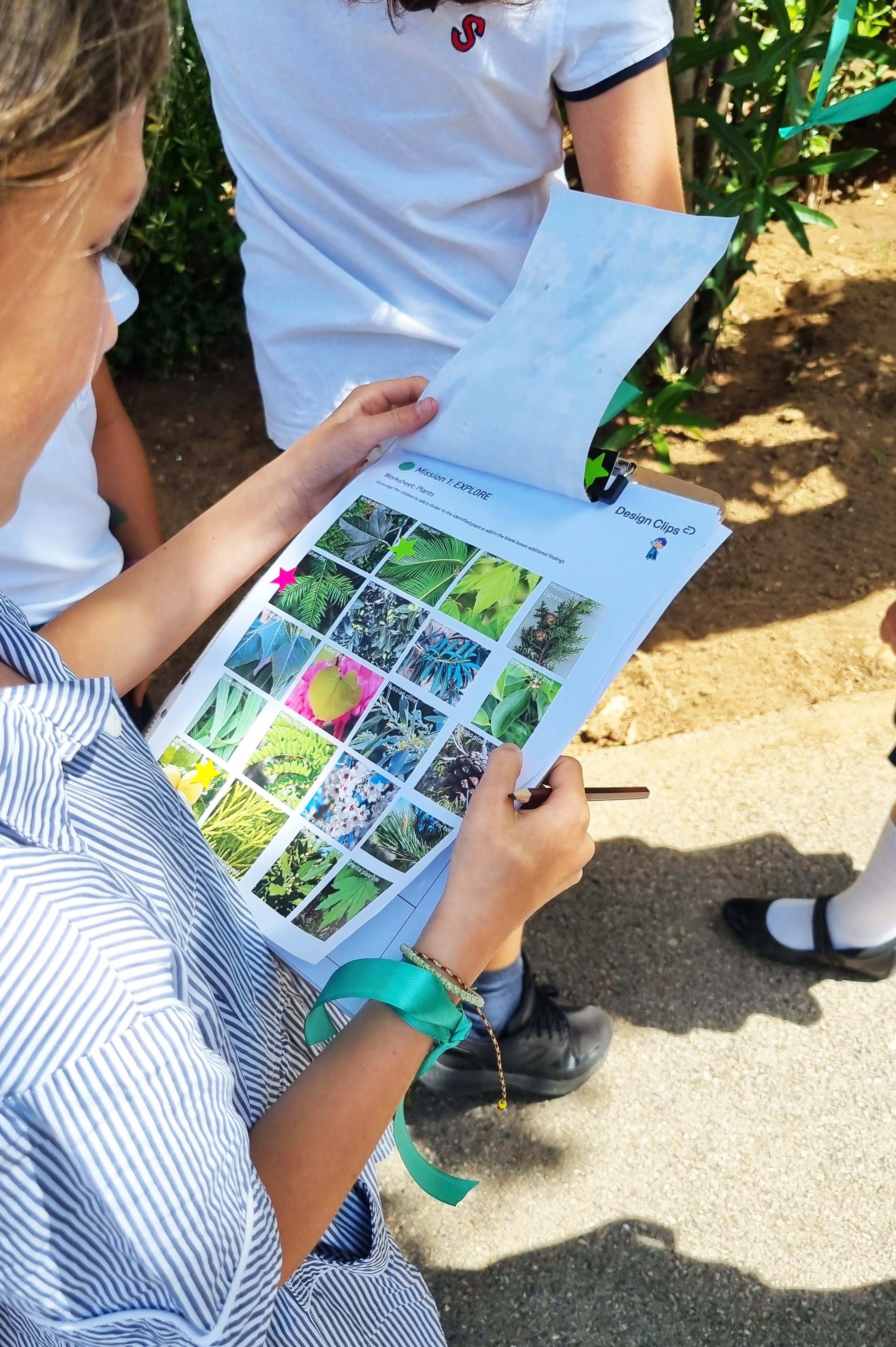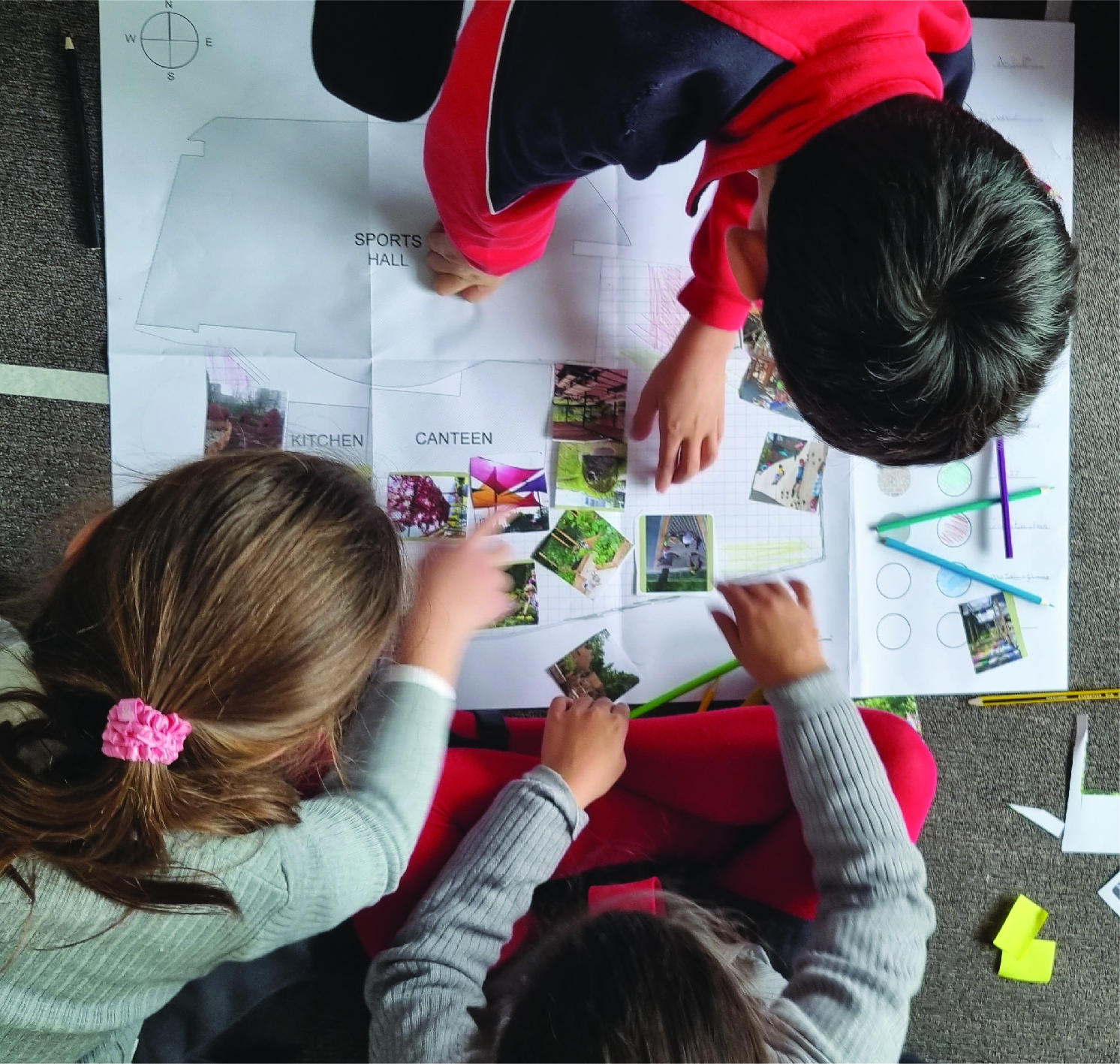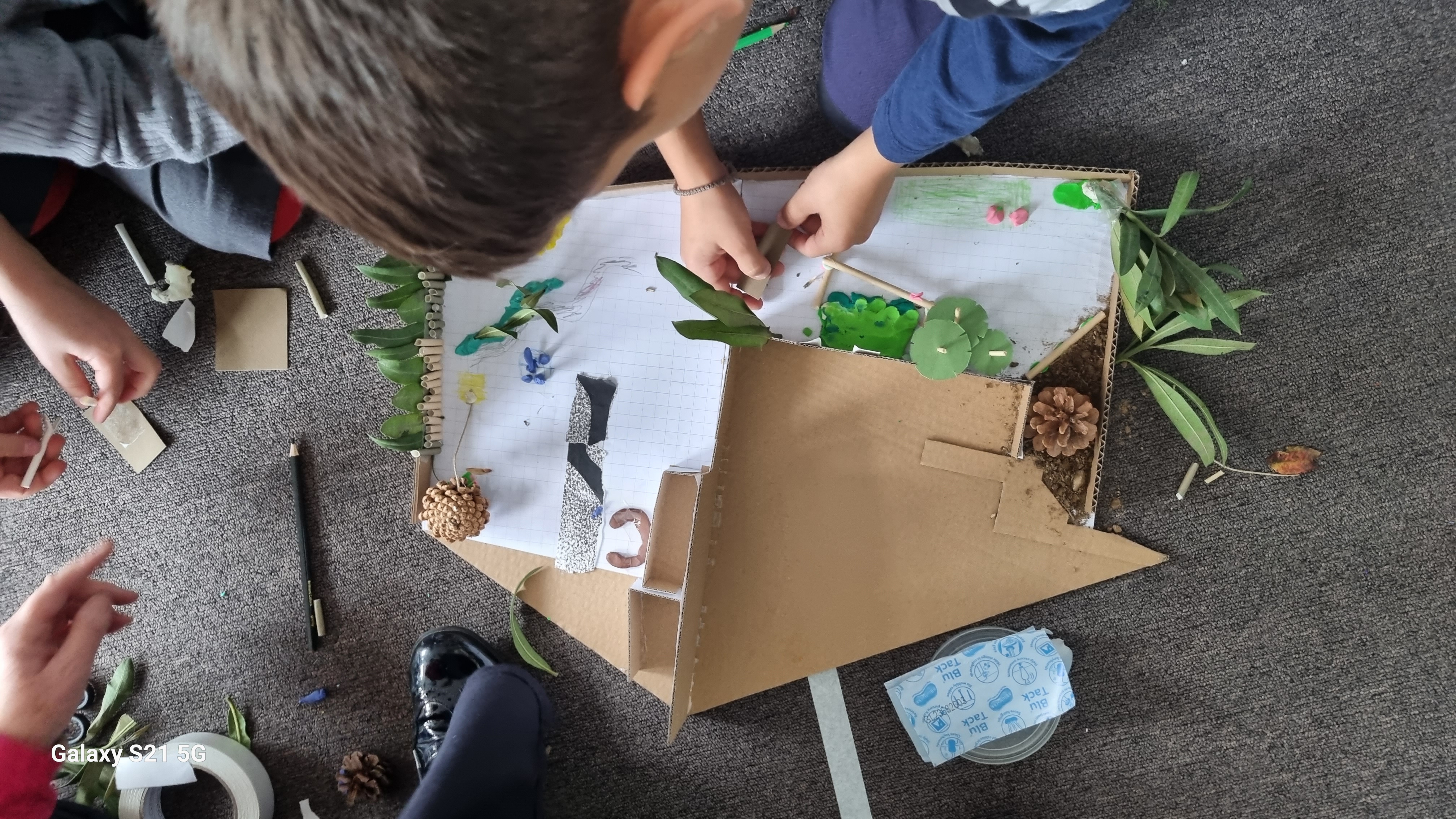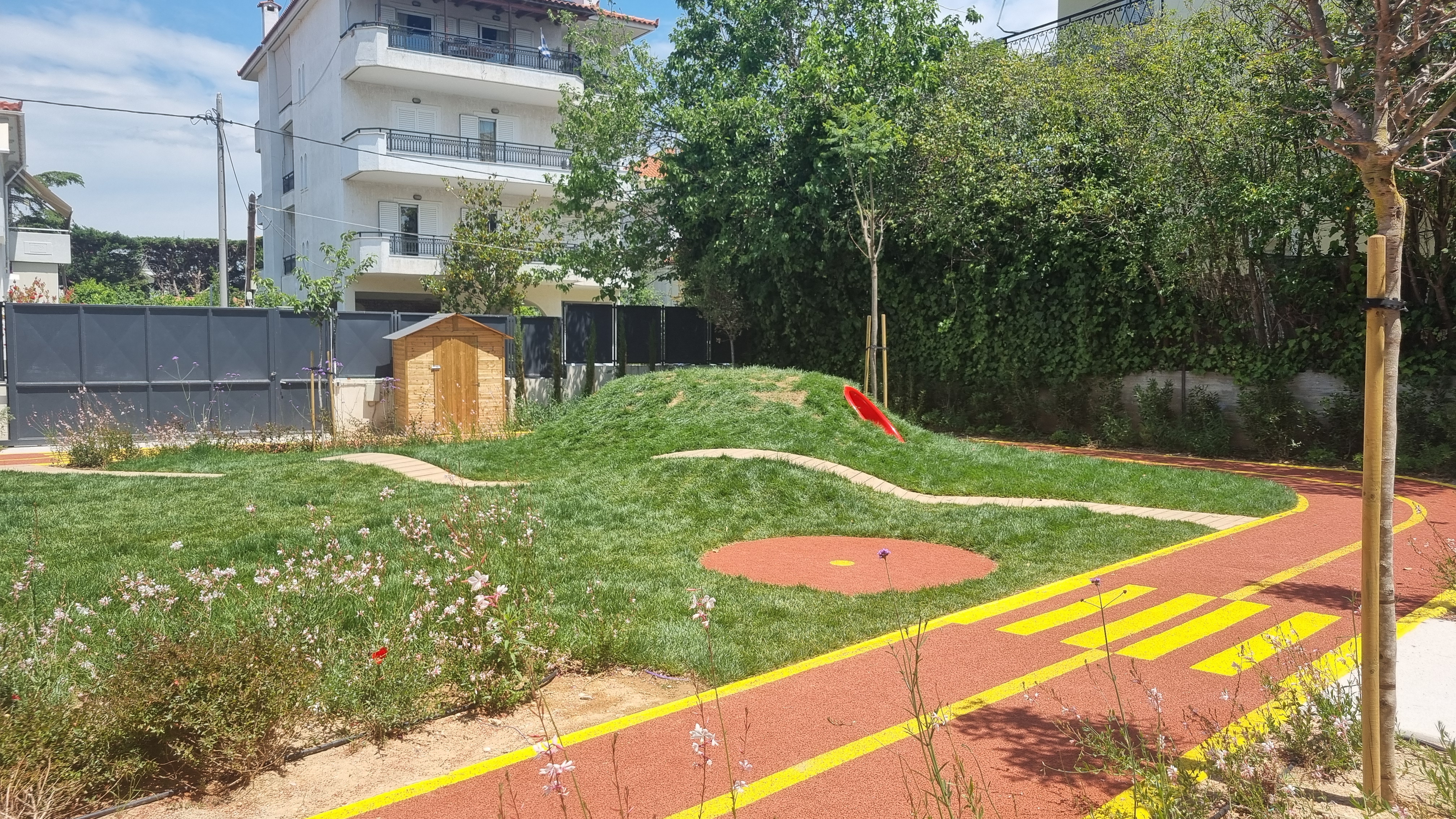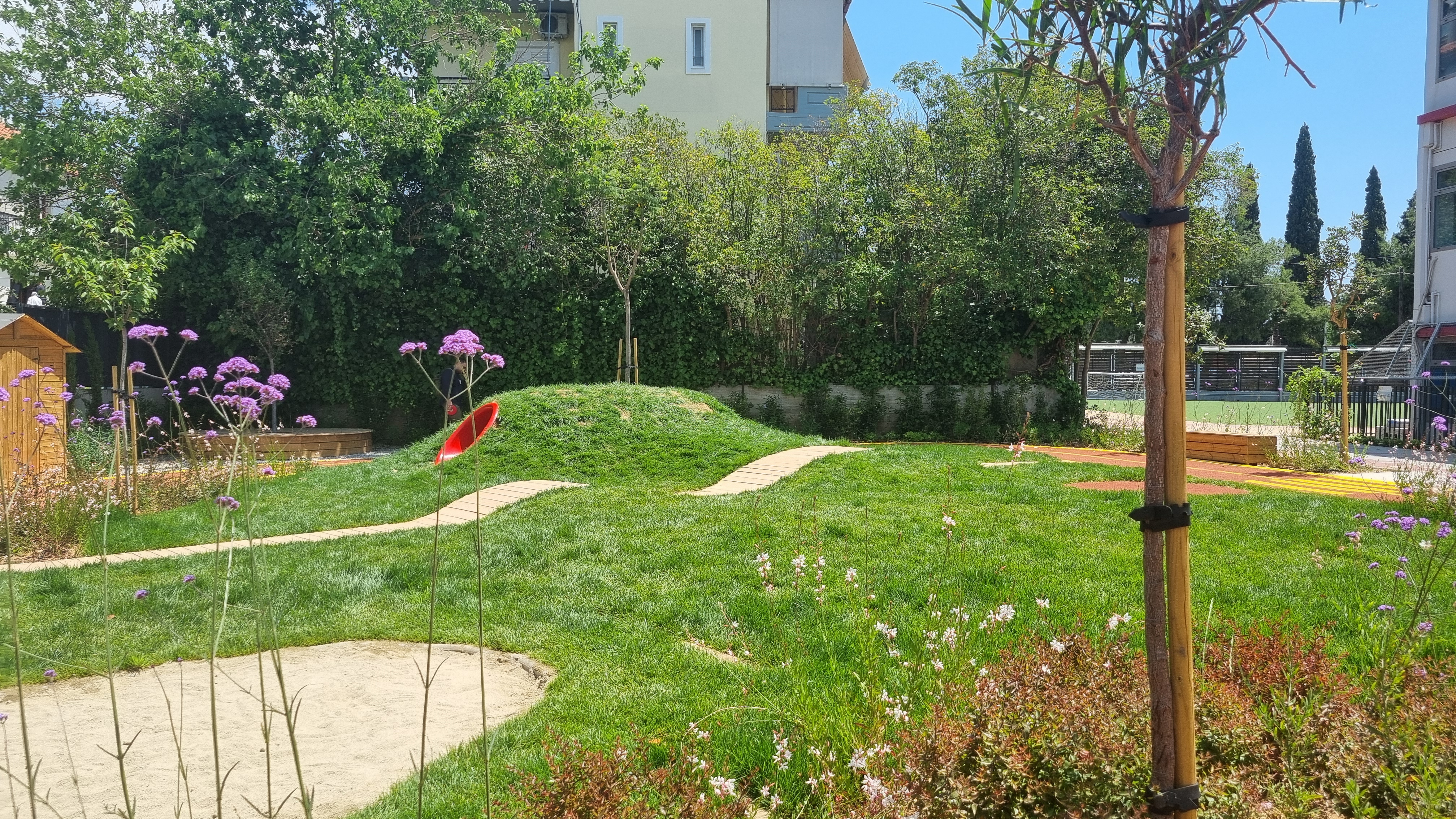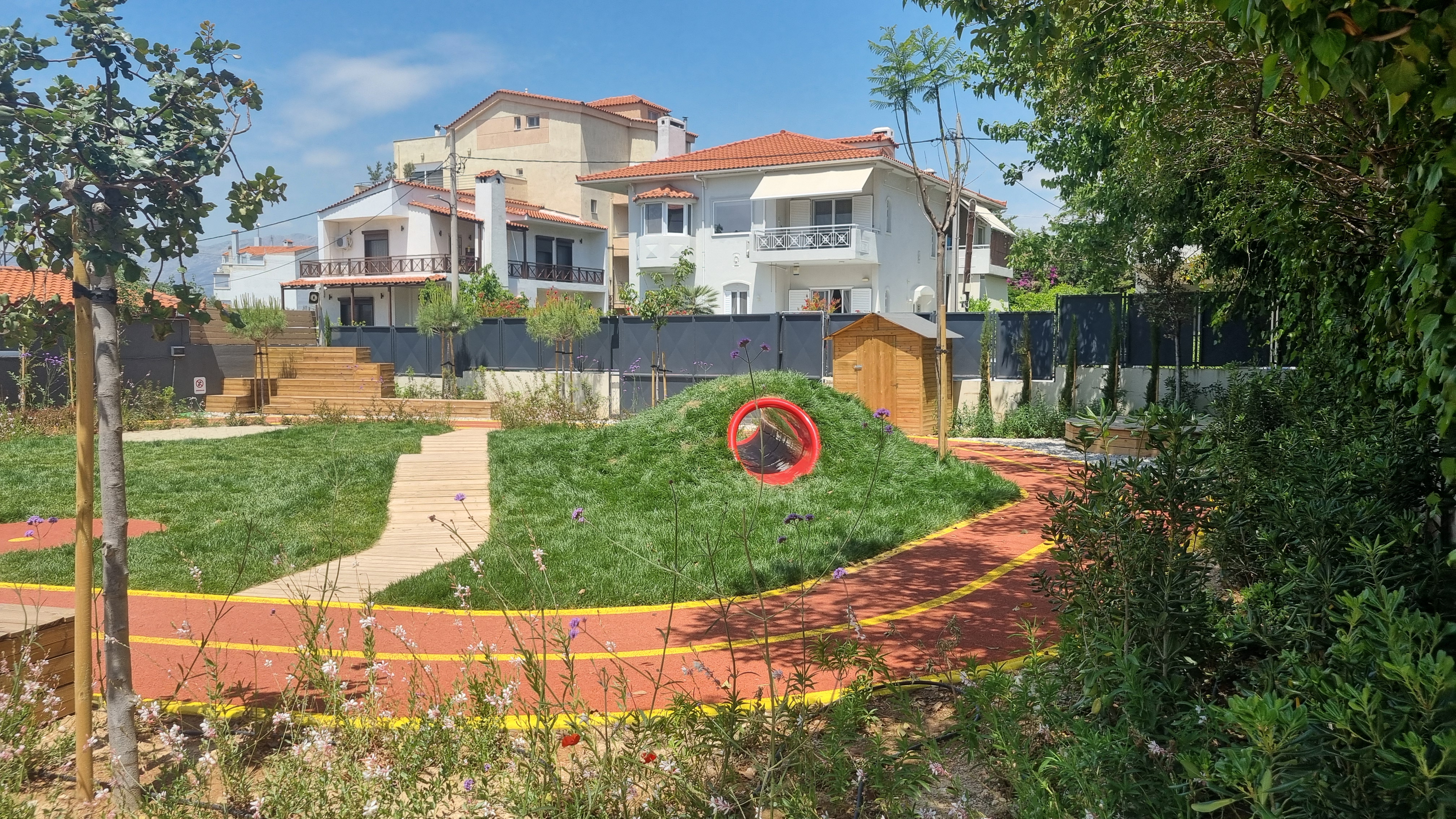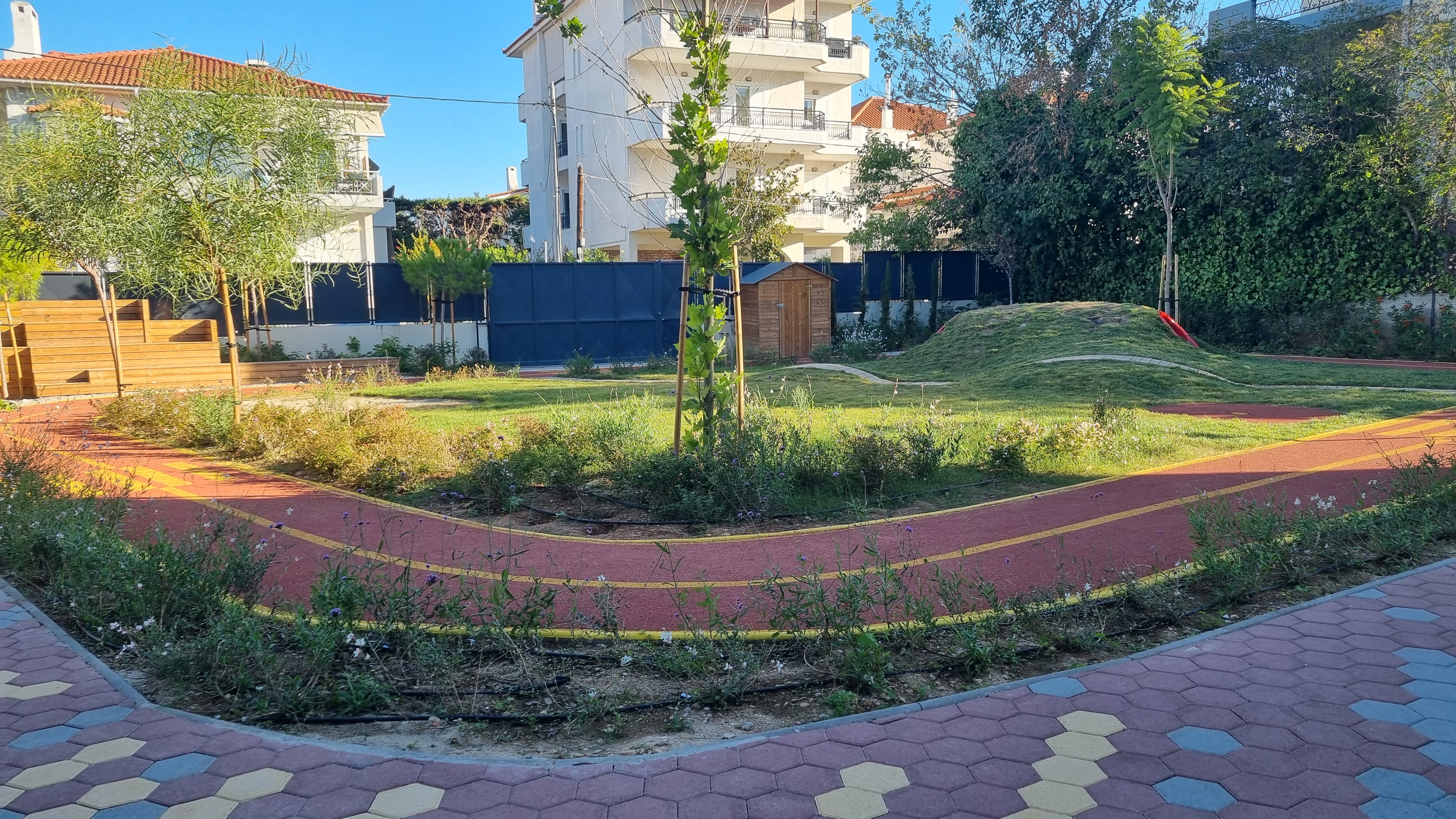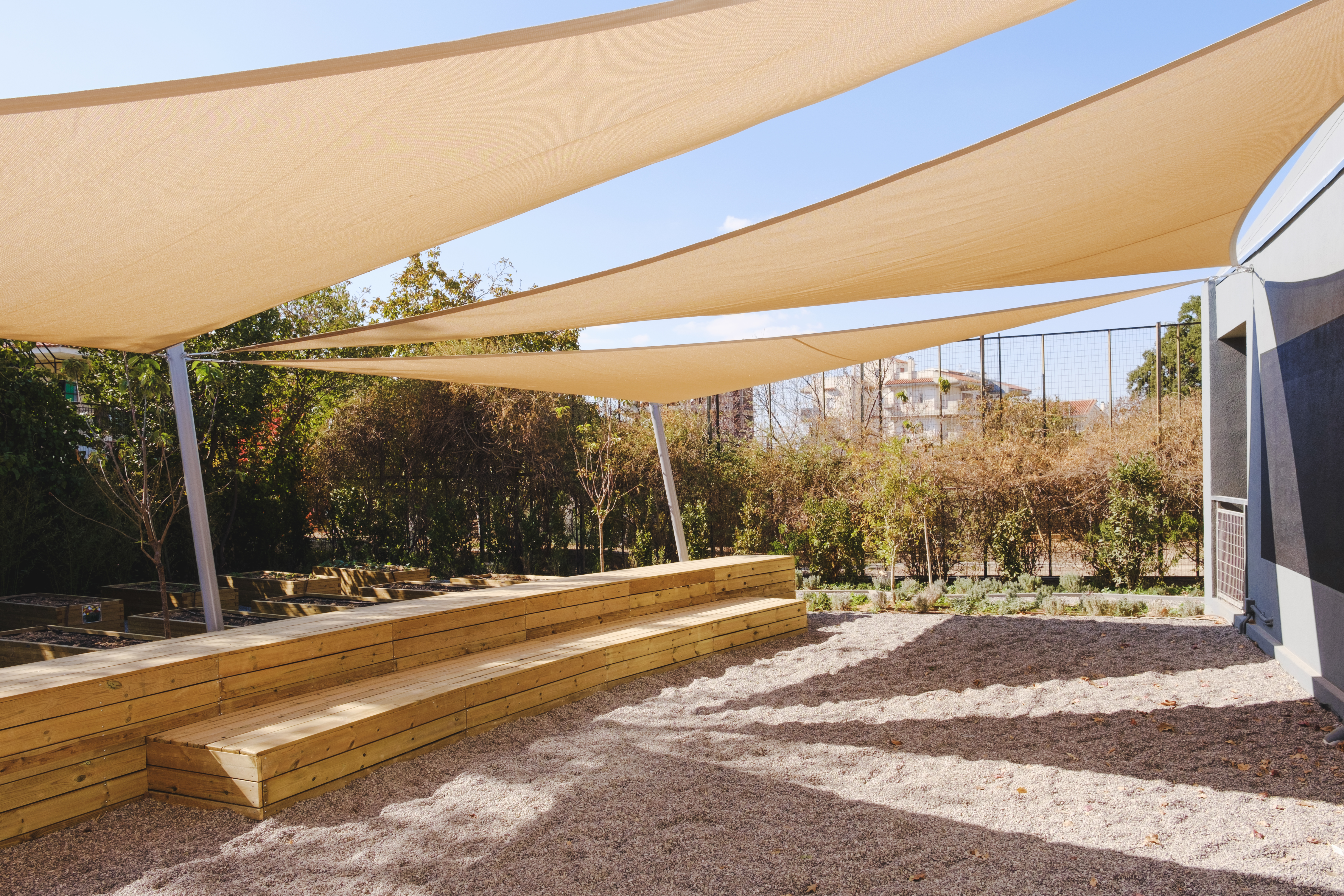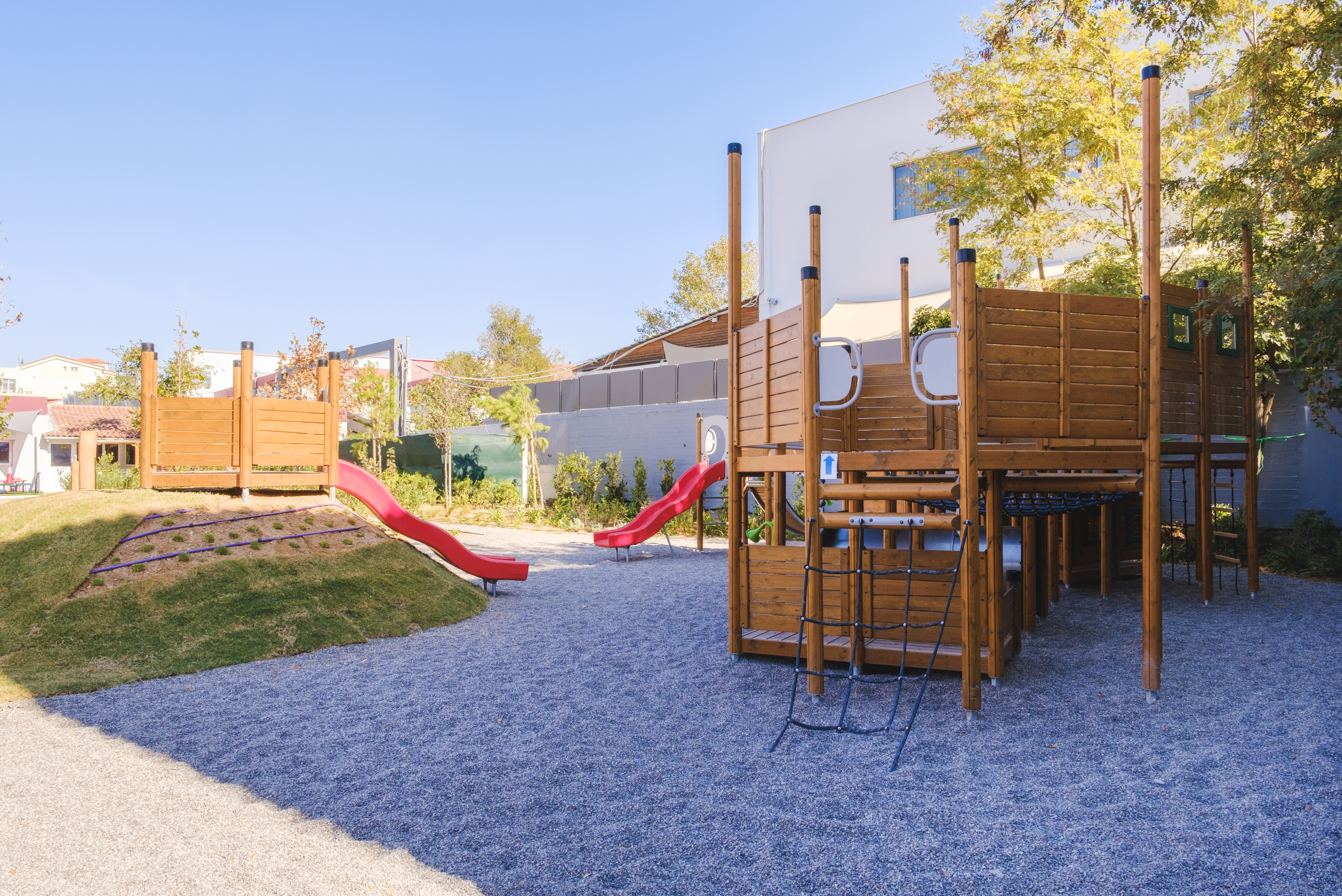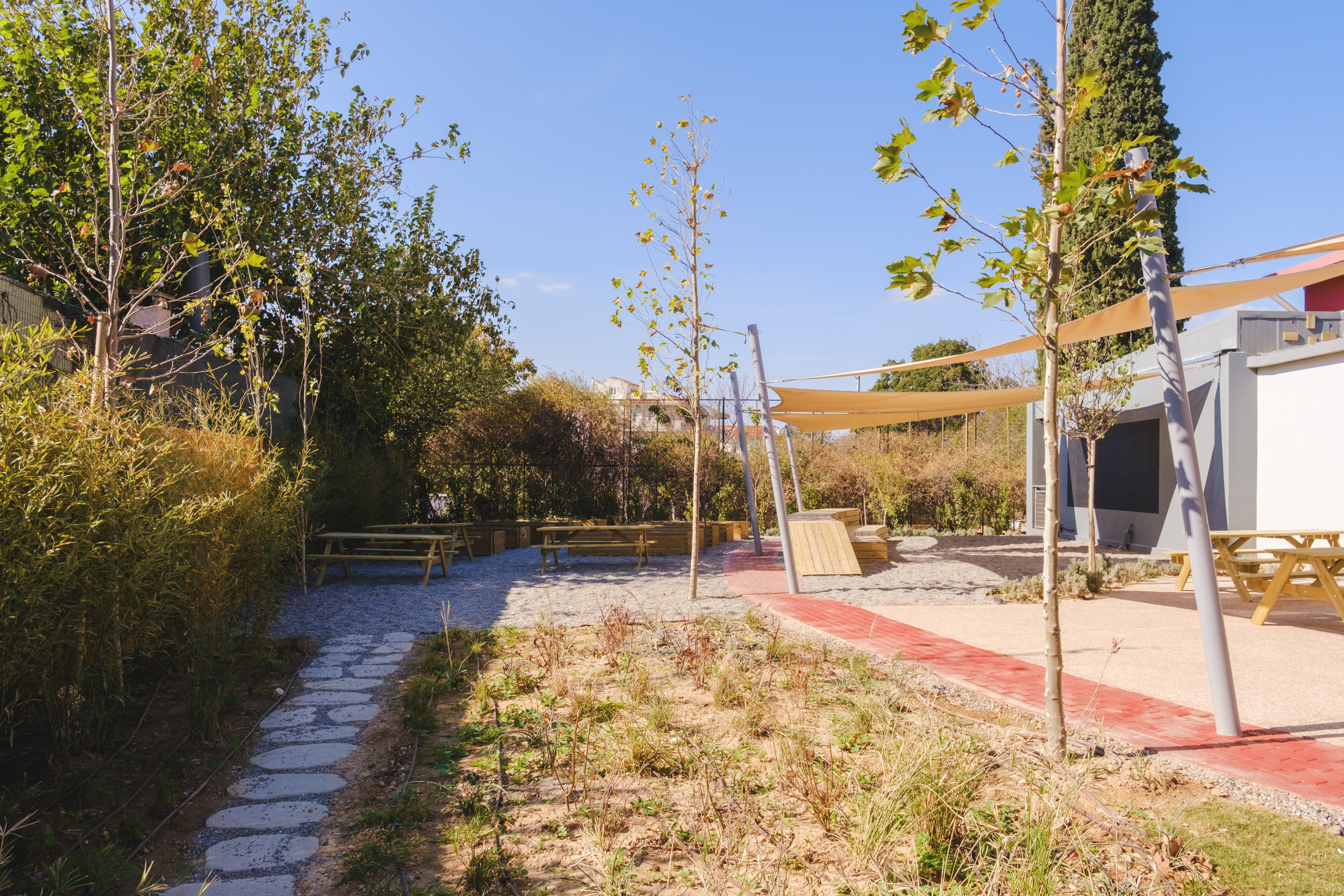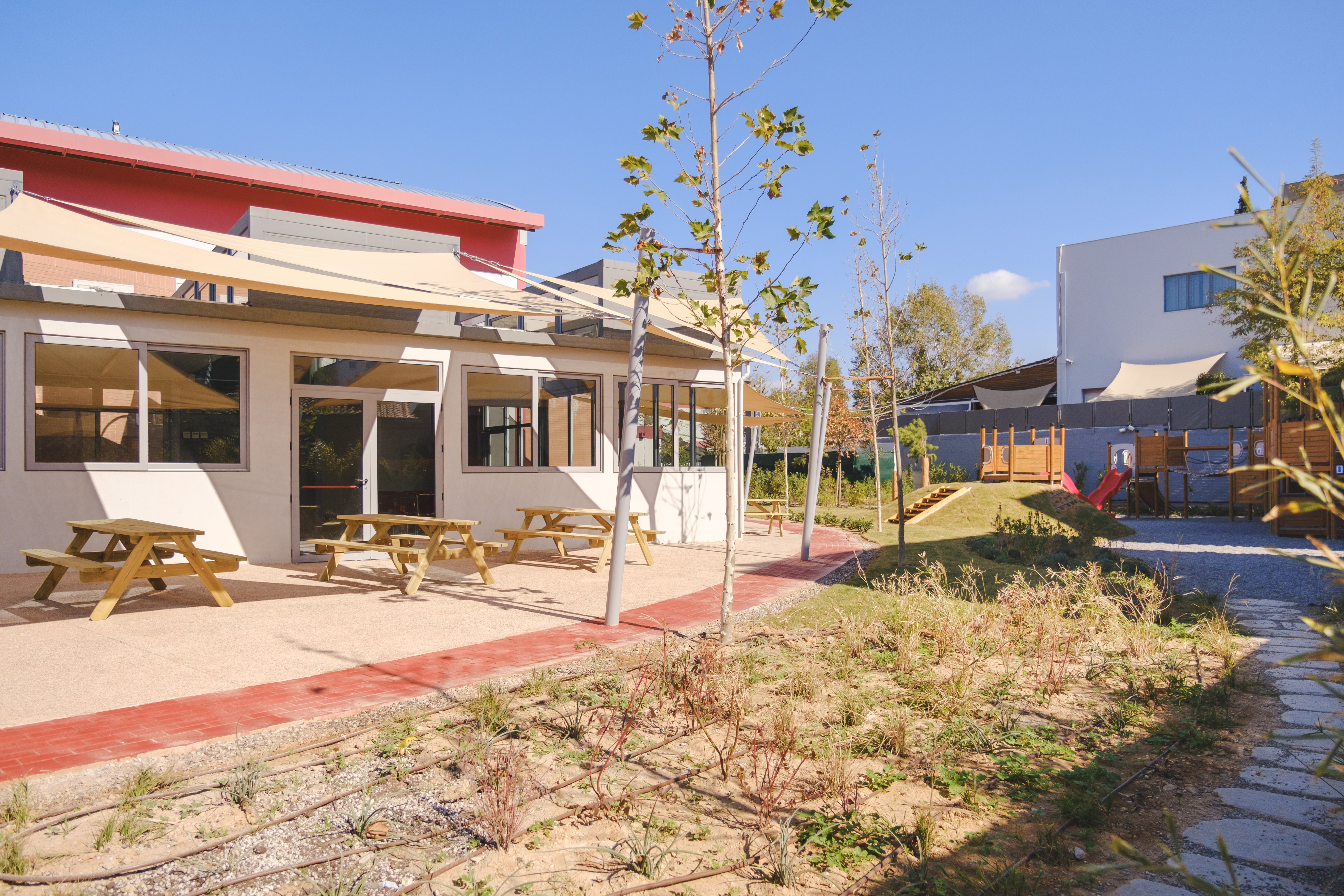Reconnecting with nature
Greening Our Schoolyards
Greening Our Schoolyards: Transforming an Asphalt-Covered Campus Together with the School Community
Greening Our Schoolyards is a participatory project that transforms an asphalt-covered campus into a sustainable, inclusive, and nature-based space for children.
Greece
Local
District of Lykovrissi, Municipality of Kifissia, Metropolitan Area of Athens, Greece
Mainly urban
It refers to a physical transformation of the built environment (hard investment)
Yes
2024-10-23
No
No
No
As a representative of an organisation, in partnership with other organisations
Greening Our Schoolyard is a participatory project that transforms two (2) asphalt-covered
schoolyards into sustainable, inclusive, and nature-based spaces for children
and educators. Rooted in the school’s strong commitment to fostering an
environmentally responsible community, the project empowers children and the
broader school community to actively participate in reshaping their outdoor
environment through co-design workshops and hands-on activities. Overall, the project
aims to involve children in the design process, introduce sensory landscapes,
incorporate sustainable and low-maintenance materials, and enhance vegetation to
strengthen their connection with nature.
Although natural schoolyards has been a widely accepted approach across the world,
the Greece's regulatory framework, the legislation, and the local market culture add
significant complexity to implementing and certifying such spaces. Instead of allowing
children to engage with nature spontaneously in their daily school life, regulations
often favor dedicated green spaces with restrictive guidelines. Despite these
challenges, the project successfully introduced natural play elements, outdoor learning
areas, and edible gardens, enhancing children's well-being, promoting physical
activity, and fostering a deeper connection with nature. These features also created
new educational opportunities, seamlessly integrating outdoor learning into the school
curriculum.
By incorporating nature-based solutions alongside elegant and functional design
elements, the transformation demonstrates that schoolyards can be more than just
asphalt-covered spaces—they can be inclusive, sustainable, and inspiring
environments that support play, learning, and well-being. Building on the school's
pioneering vision and commitment to innovation, this project aspires to set a new
standard for mainstreaming natural schoolyards in Greece.
schoolyards into sustainable, inclusive, and nature-based spaces for children
and educators. Rooted in the school’s strong commitment to fostering an
environmentally responsible community, the project empowers children and the
broader school community to actively participate in reshaping their outdoor
environment through co-design workshops and hands-on activities. Overall, the project
aims to involve children in the design process, introduce sensory landscapes,
incorporate sustainable and low-maintenance materials, and enhance vegetation to
strengthen their connection with nature.
Although natural schoolyards has been a widely accepted approach across the world,
the Greece's regulatory framework, the legislation, and the local market culture add
significant complexity to implementing and certifying such spaces. Instead of allowing
children to engage with nature spontaneously in their daily school life, regulations
often favor dedicated green spaces with restrictive guidelines. Despite these
challenges, the project successfully introduced natural play elements, outdoor learning
areas, and edible gardens, enhancing children's well-being, promoting physical
activity, and fostering a deeper connection with nature. These features also created
new educational opportunities, seamlessly integrating outdoor learning into the school
curriculum.
By incorporating nature-based solutions alongside elegant and functional design
elements, the transformation demonstrates that schoolyards can be more than just
asphalt-covered spaces—they can be inclusive, sustainable, and inspiring
environments that support play, learning, and well-being. Building on the school's
pioneering vision and commitment to innovation, this project aspires to set a new
standard for mainstreaming natural schoolyards in Greece.
Nature-based solutions (NBS)
Children’s wellbeing
Outdoor learning
Nature play
Climate adaptation
Greening Our Schoolyard project aims to enhance the environmental sustainability of
the schoolyards by integrating nature-based solutions (NBS) that address critical urban
challenges such as climate change and biodiversity loss. This project transforms two
asphalt-covered schoolyards into vibrant green spaces that promote climate resilience
while improving local thermal comfort and air quality for its vulnerable users – the
children.
Grounded in ecological design principles, the project employs sustainably sourced
materials, significantly reducing its carbon footprint. The vegetation has been carefully
selected to align with local climate conditions, soil quality, and water availability. By
planting native species and creating urban wildlife-friendly zones, Greening Our
Schoolyard plays a vital role in protecting and enhancing local biodiversity.
Furthermore, this nature-based approach supports long-term economic benefits by
reducing future maintenance costs and implementing sustainable urban practices that
minimize irrigation needs. It also fosters resilient infrastructure capable of
withstanding acute challenges, such as surface flooding.
By encouraging children’s outdoor learning and nature play, the project serves as an
exemplary model for environmentally conscious schoolyard design. It demonstrates
how green, sustainable spaces can transform urban environments while fostering
children's engagement with nature and promoting ecological stewardship for future
generations.
the schoolyards by integrating nature-based solutions (NBS) that address critical urban
challenges such as climate change and biodiversity loss. This project transforms two
asphalt-covered schoolyards into vibrant green spaces that promote climate resilience
while improving local thermal comfort and air quality for its vulnerable users – the
children.
Grounded in ecological design principles, the project employs sustainably sourced
materials, significantly reducing its carbon footprint. The vegetation has been carefully
selected to align with local climate conditions, soil quality, and water availability. By
planting native species and creating urban wildlife-friendly zones, Greening Our
Schoolyard plays a vital role in protecting and enhancing local biodiversity.
Furthermore, this nature-based approach supports long-term economic benefits by
reducing future maintenance costs and implementing sustainable urban practices that
minimize irrigation needs. It also fosters resilient infrastructure capable of
withstanding acute challenges, such as surface flooding.
By encouraging children’s outdoor learning and nature play, the project serves as an
exemplary model for environmentally conscious schoolyard design. It demonstrates
how green, sustainable spaces can transform urban environments while fostering
children's engagement with nature and promoting ecological stewardship for future
generations.
The Greening Our Schoolyard project aims to create a nature-based spaces for children
and the entire school community, demonstrating that ecological sustainability and
beauty can coexist. This initiative harmoniously integrates thoughtful landscaping and
architectural design with nature play equipment, resulting in an inspiring learning
environment. School grounds are where children spend a significant part of their day,
and thus this environment can profoundly influence their aesthetic and emotional wellbeing.
These natural schoolyards foster children's physical and holistic development through
intentional design and the use of natural materials. They create an environment that
supports physical well-being by providing opportunities for active play and movement,
facilitating daily interactions with nature and outdoor learning, ensuring cleaner and
fresher air, and establishing a comfortable and welcoming microclimate. Additionally,
the design encourages children's balanced development through dedicated spaces for
psychomotor skill development, sensory exploration and discovery, and building
meaningful connections with nature and the environment, all while stimulating
imagination and creativity.
Our overarching design principles included replacing at least 20-30% of hard flooring
with permeable surfaces, aiming to increase significantly the existing vegetation and
foliage for enhancing users’ thermal comfort and overall experience, and integrating
nature-based learning into the schoolyard's design. Furthermore, the project provides
spaces for all children to enjoy and feel included, offering sports areas, quiet zones,
reading nooks, exploration playspaces, and materials for experimentation. By fostering
children's participation in designing their outdoor spaces and activating underutilized
areas, the project significantly increases the percentage of quality outdoor space per
pupil.
and the entire school community, demonstrating that ecological sustainability and
beauty can coexist. This initiative harmoniously integrates thoughtful landscaping and
architectural design with nature play equipment, resulting in an inspiring learning
environment. School grounds are where children spend a significant part of their day,
and thus this environment can profoundly influence their aesthetic and emotional wellbeing.
These natural schoolyards foster children's physical and holistic development through
intentional design and the use of natural materials. They create an environment that
supports physical well-being by providing opportunities for active play and movement,
facilitating daily interactions with nature and outdoor learning, ensuring cleaner and
fresher air, and establishing a comfortable and welcoming microclimate. Additionally,
the design encourages children's balanced development through dedicated spaces for
psychomotor skill development, sensory exploration and discovery, and building
meaningful connections with nature and the environment, all while stimulating
imagination and creativity.
Our overarching design principles included replacing at least 20-30% of hard flooring
with permeable surfaces, aiming to increase significantly the existing vegetation and
foliage for enhancing users’ thermal comfort and overall experience, and integrating
nature-based learning into the schoolyard's design. Furthermore, the project provides
spaces for all children to enjoy and feel included, offering sports areas, quiet zones,
reading nooks, exploration playspaces, and materials for experimentation. By fostering
children's participation in designing their outdoor spaces and activating underutilized
areas, the project significantly increases the percentage of quality outdoor space per
pupil.
Greening Our Schoolyard project proudly supports children's inclusion in the co-design
process of their schoolyard. Its participatory design process ensures that their voices
are at the forefront, creating a space that reflects their diverse needs and experiences.
Unlike adult designers and architects, children experience outdoor spaces differently,
particularly in relation to climate change and urban heat. Through hands-on activities
and direct involvement, children expressed their needs for shaded, cool areas that
provide relief from extreme heat, as well as playful, nature-integrated spaces that
encourage movement, exploration, learning about nature and social interaction.
Their input led to designing solutions that balance fun with functionalities such as tree
canopies for natural cooling and shaded outdoor learning areas, to enhance thermal
comfort during warmer months or a vegetable garden to grow their own vegetables or
adventurous play establishments that spark their imagination and creativity for play.
By centering children’s perspectives, the project ensures the schoolyards are not just
aesthetically pleasing, but also a climate-adaptive, inclusive, and enriching space that
supports their well-being in the face of changing environmental challenges.
Participation enhances the sense of ownership and belonging, which is essential for
children’s emotional well-being, allowing them to feel rooted in a space that
acknowledges their needs and values.
Additionally, the schoolyard design promotes collaborative activities, such as
gardening or outdoor classrooms, where children learn the value of working together
and supporting each other. Additionally, the nature-based elements of the design
encourage interaction with nature, which can have multiple benefits for children’s physical and mental health.
process of their schoolyard. Its participatory design process ensures that their voices
are at the forefront, creating a space that reflects their diverse needs and experiences.
Unlike adult designers and architects, children experience outdoor spaces differently,
particularly in relation to climate change and urban heat. Through hands-on activities
and direct involvement, children expressed their needs for shaded, cool areas that
provide relief from extreme heat, as well as playful, nature-integrated spaces that
encourage movement, exploration, learning about nature and social interaction.
Their input led to designing solutions that balance fun with functionalities such as tree
canopies for natural cooling and shaded outdoor learning areas, to enhance thermal
comfort during warmer months or a vegetable garden to grow their own vegetables or
adventurous play establishments that spark their imagination and creativity for play.
By centering children’s perspectives, the project ensures the schoolyards are not just
aesthetically pleasing, but also a climate-adaptive, inclusive, and enriching space that
supports their well-being in the face of changing environmental challenges.
Participation enhances the sense of ownership and belonging, which is essential for
children’s emotional well-being, allowing them to feel rooted in a space that
acknowledges their needs and values.
Additionally, the schoolyard design promotes collaborative activities, such as
gardening or outdoor classrooms, where children learn the value of working together
and supporting each other. Additionally, the nature-based elements of the design
encourage interaction with nature, which can have multiple benefits for children’s physical and mental health.
Greening Our Schoolyard project places community participation at its core, ensuring
that those most affected (children and educators) are actively involved in shaping their
environment. The participatory co-design process empowered children to take a
leading role in envisioning and transforming their schoolyard. Through creative
workshops, hands-on design activities, and structured discussions, they identified their
needs, expressed their preferences, and contributed to decisions about the final
design. This involvement not only resulted in a schoolyard that genuinely reflects their
aspirations and experiences making them happy and confident, but also instilled a
sense of ownership, encouraging long-term care and engagement with their
schoolyard and nature.
Educators also played a crucial role, providing valuable insights into how the outdoor
environment could support learning, play, and overall well-being. Their feedback
helped integrate nature-based learning opportunities and flexible spaces that
accommodate outdoor classes and diverse activities. Key educators also co-facilitated
the participatory activities creating a safe and familiar space for children to feel
comfortable and express themselves. Apart from direct involvement in the design
phase, teachers now incorporate the transformed schoolyard into daily educational
activities, maximizing its benefits for students, from growing vegetables to exploring
the local biodiversity and imaginative play as part of the curriculum.
By giving children and educators a voice in decision-making, Greening Our Schoolyard
has empowered them to shape not only their immediate environment but also their
mindset toward sustainability, collaboration, and active citizenship. This participatory
approach sets a precedent for future projects, encouraging broader community
involvement in urban greening and sustainable schoolyard transformations.
that those most affected (children and educators) are actively involved in shaping their
environment. The participatory co-design process empowered children to take a
leading role in envisioning and transforming their schoolyard. Through creative
workshops, hands-on design activities, and structured discussions, they identified their
needs, expressed their preferences, and contributed to decisions about the final
design. This involvement not only resulted in a schoolyard that genuinely reflects their
aspirations and experiences making them happy and confident, but also instilled a
sense of ownership, encouraging long-term care and engagement with their
schoolyard and nature.
Educators also played a crucial role, providing valuable insights into how the outdoor
environment could support learning, play, and overall well-being. Their feedback
helped integrate nature-based learning opportunities and flexible spaces that
accommodate outdoor classes and diverse activities. Key educators also co-facilitated
the participatory activities creating a safe and familiar space for children to feel
comfortable and express themselves. Apart from direct involvement in the design
phase, teachers now incorporate the transformed schoolyard into daily educational
activities, maximizing its benefits for students, from growing vegetables to exploring
the local biodiversity and imaginative play as part of the curriculum.
By giving children and educators a voice in decision-making, Greening Our Schoolyard
has empowered them to shape not only their immediate environment but also their
mindset toward sustainability, collaboration, and active citizenship. This participatory
approach sets a precedent for future projects, encouraging broader community
involvement in urban greening and sustainable schoolyard transformations.
The Greening Our Schoolyard project was the result of teamwork and cross-sectoral
collaboration, ensuring high quality from the initial stages through to thoughtful design
and quality construction. The school played a pivotal role in coordinating the process
among all involved stakeholders, fostering an enabling environment for smooth
collaboration.
The design team developed and facilitated participatory activities that laid the
groundwork for the design phase. They ensured that the final outcomes aligned with
the insights gathered during the participatory process, as well as local climate
conditions, sustainable design principles, and relevant legislation. During the
construction phase, the construction team maintained regular communication with the
design team to ensure the highest quality of the final outcome.
The stakeholders involved in this collaborative effort included:
• School: St. Catherine’s British School in Athens
• Design Team: Design Clips (Urban Design Studio) & Fytron Landscapes (Landscape
Design Studio)
• Construction Supervision: Dream Office
• Construction: GDM Assets
• Landscape Construction: Landmacon SA
• Play Equipment: Minouli Ltd.
collaboration, ensuring high quality from the initial stages through to thoughtful design
and quality construction. The school played a pivotal role in coordinating the process
among all involved stakeholders, fostering an enabling environment for smooth
collaboration.
The design team developed and facilitated participatory activities that laid the
groundwork for the design phase. They ensured that the final outcomes aligned with
the insights gathered during the participatory process, as well as local climate
conditions, sustainable design principles, and relevant legislation. During the
construction phase, the construction team maintained regular communication with the
design team to ensure the highest quality of the final outcome.
The stakeholders involved in this collaborative effort included:
• School: St. Catherine’s British School in Athens
• Design Team: Design Clips (Urban Design Studio) & Fytron Landscapes (Landscape
Design Studio)
• Construction Supervision: Dream Office
• Construction: GDM Assets
• Landscape Construction: Landmacon SA
• Play Equipment: Minouli Ltd.
To successfully complete Greening Our Schoolyard, a diverse range of expertise was
required, ensuring a holistic approach that integrates child-centered design,
sustainability, and construction feasibility. This rich exchange of knowledge created a
dynamic collaboration between architects, ecologists, engineers, play equipment
manufacturers, certifying agencies, educators, and the school community.
• Child-Friendly Architecture & Urban Design- Experts in children’s participation: their
expertise helped translate children's ideas into functional design elements that
support both structured and unstructured play.
• Landscape Design & Ecology- Experts in nature-based design and biodiversity: their
expertise contributed to the selection of native plants and habitat-creating features,
ensuring the schoolyard promotes ecological sustainability and supports local wildlife.
• Material Technology & Construction: Knowledge of sustainable and durable materials
was essential in ensuring the longevity of the project while minimizing its
environmental footprint. Choosing permeable surfaces and natural materials enhanced
the schoolyard’s climate resilience and overall usability of the space.
• Play equipment manufacturing & play safety standards
• Education: provided insights into how children engage with outdoor environments, ensuring that the design fostered learning, creativity, and well-being.
At the same time, engaging the school community (children & educators)
strengthened the design process by drawing on local knowledge and real-life
experiences. The participatory approach ensured that not only experts but also the
users were part of shaping the space. This synergy resulted in a schoolyard that is not
only functional and sustainable but also deeply connected to the needs and aspirations
of its users, making it a model for future projects.
required, ensuring a holistic approach that integrates child-centered design,
sustainability, and construction feasibility. This rich exchange of knowledge created a
dynamic collaboration between architects, ecologists, engineers, play equipment
manufacturers, certifying agencies, educators, and the school community.
• Child-Friendly Architecture & Urban Design- Experts in children’s participation: their
expertise helped translate children's ideas into functional design elements that
support both structured and unstructured play.
• Landscape Design & Ecology- Experts in nature-based design and biodiversity: their
expertise contributed to the selection of native plants and habitat-creating features,
ensuring the schoolyard promotes ecological sustainability and supports local wildlife.
• Material Technology & Construction: Knowledge of sustainable and durable materials
was essential in ensuring the longevity of the project while minimizing its
environmental footprint. Choosing permeable surfaces and natural materials enhanced
the schoolyard’s climate resilience and overall usability of the space.
• Play equipment manufacturing & play safety standards
• Education: provided insights into how children engage with outdoor environments, ensuring that the design fostered learning, creativity, and well-being.
At the same time, engaging the school community (children & educators)
strengthened the design process by drawing on local knowledge and real-life
experiences. The participatory approach ensured that not only experts but also the
users were part of shaping the space. This synergy resulted in a schoolyard that is not
only functional and sustainable but also deeply connected to the needs and aspirations
of its users, making it a model for future projects.
Greening Our Schoolyard project brings innovative solutions to the traditional
schoolyard in Greece, which is often dominated by hard surfaces, lacks greenery, and
offers little opportunity for outdoor learning. Unlike the common top-down approach to
school design in Greece, this project incorporates a participatory co-design process
where children actively shape their environment. Through hands-on workshops,
children are encouraged to explore materials, spatial qualities, and biodiversity,
ensuring the schoolyard reflects their preferences and needs. This is a significant
departure from the standard practice of excluding children from the design process.
In contrast to the typical asphalt-covered schoolyards in Greece, this project
introduces green, nature-based solutions that provide cooler, more inviting spaces for
play and learning. It replaces heat-absorbing surfaces with trees, plants, and
permeable materials that help mitigate the urban heat island effect and improve
comfort during warm months. The schoolyard also incorporates nature play elements,
such as hills, wooden structures, sensory landscapes offering children opportunities for
creative engagement with nature. Additionally, by introducing outdoor classrooms, the
project promotes outdoor learning and experiential education.
schoolyard in Greece, which is often dominated by hard surfaces, lacks greenery, and
offers little opportunity for outdoor learning. Unlike the common top-down approach to
school design in Greece, this project incorporates a participatory co-design process
where children actively shape their environment. Through hands-on workshops,
children are encouraged to explore materials, spatial qualities, and biodiversity,
ensuring the schoolyard reflects their preferences and needs. This is a significant
departure from the standard practice of excluding children from the design process.
In contrast to the typical asphalt-covered schoolyards in Greece, this project
introduces green, nature-based solutions that provide cooler, more inviting spaces for
play and learning. It replaces heat-absorbing surfaces with trees, plants, and
permeable materials that help mitigate the urban heat island effect and improve
comfort during warm months. The schoolyard also incorporates nature play elements,
such as hills, wooden structures, sensory landscapes offering children opportunities for
creative engagement with nature. Additionally, by introducing outdoor classrooms, the
project promotes outdoor learning and experiential education.
For the Greening Our Schoolyard project we developed a multi-stage and participatory
approach that prioritizes children's voices in the co-design process, ensuring the
creation of a nature-based space that reflects their diverse needs and experiences.
By integrating thoughtful landscaping and architectural design with nature play
equipment, the project fosters an inspiring learning environment that supports
children's holistic development. Through hands-on activities, children expressed their
desires for shaded, cool areas and playful, nature-integrated spaces, leading to
functional design solutions such as tree canopies, shaded learning zones, and
vegetable gardens. This inclusive process enhances children's sense of ownership and
belonging, promoting emotional well-being while also encouraging collaboration
through activities like gardening and outdoor classrooms.
Additionally, we employed a collaborative approach among all stakeholders throughout
the entire project cycle, from engagement and conception to construction coordination
and implementation. Our multi-stage project roadmap ensured that all stakeholders
were equally heard while ensuring that the project complies with all relevant standards
and regulations.
The roadmap included the following stages:
1. Project preparation
2. Co-Assessment with school community
3. Masterplan / preliminary design
4. Stakeholder consultation
5. Co-design with school community
6. Developed Design
7. Stakeholder consultation
8. Technical drawings
9. Stakeholder confirmation
10. Construction Coordination / Permits / Procurement
11. Construction
approach that prioritizes children's voices in the co-design process, ensuring the
creation of a nature-based space that reflects their diverse needs and experiences.
By integrating thoughtful landscaping and architectural design with nature play
equipment, the project fosters an inspiring learning environment that supports
children's holistic development. Through hands-on activities, children expressed their
desires for shaded, cool areas and playful, nature-integrated spaces, leading to
functional design solutions such as tree canopies, shaded learning zones, and
vegetable gardens. This inclusive process enhances children's sense of ownership and
belonging, promoting emotional well-being while also encouraging collaboration
through activities like gardening and outdoor classrooms.
Additionally, we employed a collaborative approach among all stakeholders throughout
the entire project cycle, from engagement and conception to construction coordination
and implementation. Our multi-stage project roadmap ensured that all stakeholders
were equally heard while ensuring that the project complies with all relevant standards
and regulations.
The roadmap included the following stages:
1. Project preparation
2. Co-Assessment with school community
3. Masterplan / preliminary design
4. Stakeholder consultation
5. Co-design with school community
6. Developed Design
7. Stakeholder consultation
8. Technical drawings
9. Stakeholder confirmation
10. Construction Coordination / Permits / Procurement
11. Construction
In Athens, and across Greece, nature-based schoolyards are rare. Most schoolyards are
dominated by hard surfaces, with little to no greenery or natural play elements.
Likewise, co-designing these spaces with children is not common practice. Greening
Our Schoolyard is shifting this paradigm, proving that schoolyards can be vibrant,
inclusive, and climate-responsive spaces shaped by the very children who use them.
The project's co-design approach is highly transferable and can be applied to any
initiative involving children as users, whether in public or private spaces. By actively
engaging children in shaping their environment, this method ensures that urban
spaces are designed with their needs and preferences in mind, fostering a deeper
connection to place and a sense of ownership. This participatory model can be
replicated in schools, parks, and public spaces worldwide, reinforcing the importance
of user-led design in creating meaningful environments.
Beyond its methodology, the nature-based schoolyard model itself is adaptable to
different contexts, particularly in urban areas and countries struggling with extreme
heat and biodiversity loss. With its cooling effects, improved air quality, and increased
biodiversity, the project presents a scalable solution to mitigate urban heat islands,
benefiting not just students but the wider community. The project has already inspired
some of our clients to adopt a similar approach, and as more schools witness the
benefits of cooler, greener, and more engaging outdoor spaces, momentum for
replication is growing.
With flexibility in design and implementation, Greening Our Schoolyard serves as a
blueprint for climate-adaptive, child-centered urban design, paving the way for
healthier, happier, and more resilient future generations.
dominated by hard surfaces, with little to no greenery or natural play elements.
Likewise, co-designing these spaces with children is not common practice. Greening
Our Schoolyard is shifting this paradigm, proving that schoolyards can be vibrant,
inclusive, and climate-responsive spaces shaped by the very children who use them.
The project's co-design approach is highly transferable and can be applied to any
initiative involving children as users, whether in public or private spaces. By actively
engaging children in shaping their environment, this method ensures that urban
spaces are designed with their needs and preferences in mind, fostering a deeper
connection to place and a sense of ownership. This participatory model can be
replicated in schools, parks, and public spaces worldwide, reinforcing the importance
of user-led design in creating meaningful environments.
Beyond its methodology, the nature-based schoolyard model itself is adaptable to
different contexts, particularly in urban areas and countries struggling with extreme
heat and biodiversity loss. With its cooling effects, improved air quality, and increased
biodiversity, the project presents a scalable solution to mitigate urban heat islands,
benefiting not just students but the wider community. The project has already inspired
some of our clients to adopt a similar approach, and as more schools witness the
benefits of cooler, greener, and more engaging outdoor spaces, momentum for
replication is growing.
With flexibility in design and implementation, Greening Our Schoolyard serves as a
blueprint for climate-adaptive, child-centered urban design, paving the way for
healthier, happier, and more resilient future generations.
Climate change: By transforming the previously unwelcoming hard-surface schoolyard
to a nature-based schoolyard, the Greening Our Schoolyard project mitigates urban
heat island effect and contribute to climate resilience, by providing a pleasant outdoor
place for playing and learning for children who are particularly vulnerable to heat
stress. By replacing heat-absorbing surfaces with vegetation, trees, and permeable
materials, natural schoolyards help cool the environment, reducing local temperatures
and mitigating the effects of global warming. Shaded green spaces improve thermal
comfort, making outdoor play and learning more accessible while decreasing reliance
on artificial cooling in surrounding areas. In addition to improving air quality, these
nature-based interventions absorb carbon dioxide, contributing to climate action at a
local level.
Biodiversity loss: Greening Our Schoolyard project also supports urban biodiversity by
introducing native plants and pollinator-friendly habitats, attracting essential species
and restoring ecosystems within cities.
Children’s health and wellbeing: Beyond climate benefits, Greening Our Schoolyard
project enhances children's wellbeing by fostering daily opportunities for physical
activity, connection with nature and outdoor learning (including growing their own
vegetables) during their school routine, which may help to stress reduction and
cognitive development. This is extremely important for children growing up in urban
environments, lacking opportunities for physical activity, playing and learning through
natural environments.
to a nature-based schoolyard, the Greening Our Schoolyard project mitigates urban
heat island effect and contribute to climate resilience, by providing a pleasant outdoor
place for playing and learning for children who are particularly vulnerable to heat
stress. By replacing heat-absorbing surfaces with vegetation, trees, and permeable
materials, natural schoolyards help cool the environment, reducing local temperatures
and mitigating the effects of global warming. Shaded green spaces improve thermal
comfort, making outdoor play and learning more accessible while decreasing reliance
on artificial cooling in surrounding areas. In addition to improving air quality, these
nature-based interventions absorb carbon dioxide, contributing to climate action at a
local level.
Biodiversity loss: Greening Our Schoolyard project also supports urban biodiversity by
introducing native plants and pollinator-friendly habitats, attracting essential species
and restoring ecosystems within cities.
Children’s health and wellbeing: Beyond climate benefits, Greening Our Schoolyard
project enhances children's wellbeing by fostering daily opportunities for physical
activity, connection with nature and outdoor learning (including growing their own
vegetables) during their school routine, which may help to stress reduction and
cognitive development. This is extremely important for children growing up in urban
environments, lacking opportunities for physical activity, playing and learning through
natural environments.
Before the Greening Our Schoolyard project, the school’s outdoor spaces were
dominated by hard surfaces, including concrete and asphalt, used as a parking lot and
offering little connection to nature with limited opportunities for exploration, play, and
learning. Through the co-design process, children actively gain hands-on experience in
identifying materials, understanding spatial qualities, and discovering how design
choices impact both their environment and local wildlife. In the following design
workshops students were able to see the direct relationship between design,
biodiversity, and spatial experiences, allowing them to align their needs and
preferences with design ideas.
Greening Our Schoolyard project resulted in a vibrant, dynamic space, supporting
multiple activities throughout the school day. New outdoor learning opportunities,
including cycling on a bike track, an outdoor classroom, naturalistic and risky playing have
enriched the curriculum, helping students develop essential skills while fostering
a deeper appreciation for nature. The redesigned space not only encourages children
to spend more time outdoors due to bioclimatic design, but also enhances biodiversity,
attracting wildlife through naturalistic design and eco-friendly materials. This
transformation is more than just a change in scenery, it’s an investment in education,
wellbeing, and environmental stewardship for the next generation.
dominated by hard surfaces, including concrete and asphalt, used as a parking lot and
offering little connection to nature with limited opportunities for exploration, play, and
learning. Through the co-design process, children actively gain hands-on experience in
identifying materials, understanding spatial qualities, and discovering how design
choices impact both their environment and local wildlife. In the following design
workshops students were able to see the direct relationship between design,
biodiversity, and spatial experiences, allowing them to align their needs and
preferences with design ideas.
Greening Our Schoolyard project resulted in a vibrant, dynamic space, supporting
multiple activities throughout the school day. New outdoor learning opportunities,
including cycling on a bike track, an outdoor classroom, naturalistic and risky playing have
enriched the curriculum, helping students develop essential skills while fostering
a deeper appreciation for nature. The redesigned space not only encourages children
to spend more time outdoors due to bioclimatic design, but also enhances biodiversity,
attracting wildlife through naturalistic design and eco-friendly materials. This
transformation is more than just a change in scenery, it’s an investment in education,
wellbeing, and environmental stewardship for the next generation.

